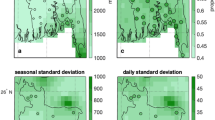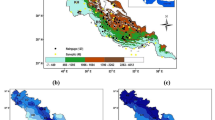Abstract
In 2022, a record-breaking monsoon caused flooding throughout Pakistan, particularly in the southern regions, resulting in deaths, property losses, and severe crop damage, affecting the food supply chain that could last for years. This study assesses the accuracy of sub-seasonal calibrated probabilistic rainfall forecasts for Pakistan. The evaluation focuses on forecasts initialized throughout the summer monsoon season (June–September) and utilizes the European Center for Medium Range Forecast (ECMWF) ensemble prediction system. Forecasts are calibrated using a canonical correlation analysis (CCA) and evaluated using cross-validated hindcasts from 2002 to 2021. The calibrated hindcasts exhibit positive ranked probability skill score and are reliable for weeks 1 (days 1–7), 2 (days 8–14), and 3 – 4 (days 15–28), lead times. In the extraordinary monsoon season of 2022, tercile-category probabilistic forecasts provided useful information up to 4 weeks ahead. Furthermore, the occurrences of intense monsoon rainfall in the highly affected southern region of Pakistan were forecasted reasonably well up to 2 weeks in advance. The ECMWF model's ability to predict sub-seasonal monsoon rainfall in Pakistan during 2022 is attributed to the model’s successful prediction of monsoonal intra-seasonal oscillations.













Similar content being viewed by others
Data availability
Different datasets used in this study are freely available at the following links; Model: https://iridl.ldeo.columbia.edu/SOURCES/.ECMWF/.S2S/.ECMF/. CHIRPS: https://iridl.ldeo.columbia.edu/SOURCES/.UCSB/.CHIRPS/
Code availability
IRI Sub-Seasonal forecasting tool can be found at; PyCPT: https://bitbucket.org/py-iri/iri-pycpt/downloads/
References
Acharya N, Ehsan MA, Admasu A et al (2021) On the next generation (NextGen) seasonal prediction system to enhance climate services over Ethiopia. Clim Serv 24:100272
Baig MB, Shahid SA, Straquadine GS (2013) Making rainfed agriculture sustainable through environmental friendly technologies in Pakistan: a review. Int Soil Water Conserv Res 1(2):36–52
Bhatti MT, Anwar AA (2022) Statistical verification of 16-day rainfall forecast for a farmers advisory service in Pakistan. Agric for Meteorol 317:108888
Doblas-Reyes FJ, Hagedorn R, Palmer TN (2005) The rationale behind the success of multi-model ensembles in seasonal forecasting—II. Calibration and combination. Tellus A Dyn Meteorol Oceanogr 57(3):234–252
Ehsan MA, SIngh B (2023) Forecast skill of Bangladesh summer monsoon rainfall in C3S and NMME models after calibration. Dyn Atmos Oceans 104:101410. https://doi.org/10.1016/j.dynatmoce.2023.101410
Ehsan MA, Tippett MK, Kucharski F et al (2020) Predicting peak summer monsoon precipitation over Pakistan in ECMWF SEAS5 and North American Multimodel Ensemble. Int J Climatol 40(13):5556–5573
Ehsan MA, Tippett MK, Robertson AW et al (2023) The ENSO fingerprint on bangladesh summer monsoon rainfall. Earth Syst Environ 7:617–627. https://doi.org/10.1007/s41748-023-00347-z
Faisal N, Sadiq N (2012) Monsoon onset over selected eastern boundary cities of Pakistan. The Nucleus 49(3):239–245
Funk C, Peterson P, Landsfeld M et al (2015) The climate hazards infrared precipitation with stations—a new environmental record for monitoring extremes. Sci Data 2(1):1–21
Goddard L, Mason SJ, Zebiak SE et al (2001) Current approaches to seasonal to interannual climate predictions. Int J Climatol J R Meteorol Soc 21(9):1111–1152
Goswami BN, Mohan RA (2001) Intraseasonal oscillations and interannual variability of the Indian summer monsoon. J Clim 14(6):1180–1198
Goswami BN, Wu G, Yasunari T (2006) The annual cycle, intraseasonal oscillations, and roadblock to seasonal predictability of the Asian summer monsoon. J Clim 19(20):5078–5099
Hussain S, Mubeen M, Nasim W et al (2023) Investigation of irrigation water requirement and evapotranspiration for water resource management in southern Punjab, Pakistan. Sustainability 15(3):1768. https://doi.org/10.3390/su15031768
Iqbal MS, Dahri ZH, Querner EP, Khan A et al (2018) Impact of climate change on flood frequency and intensity in the Kabul River Basin. Geosciences 8(4):114
Kirsch TD, Wadhwani C, Sauer L et al (2012) Impact of the 2010 Pakistan floods on rural and urban populations at 6 months. PLoS Curr. https://doi.org/10.1371/4fdfb212d2432
Lau WK, Kim KM (2012) The 2010 Pakistan flood and Russian heat wave: teleconnection of hydrometeorological extremes. J Hydrometeorol 13(1):392–403
Liebmann B, Smith CA (1996) Description of a complete (interpolated) outgoing longwave radiation dataset. Bull Am Meteorol Soc 77(6):1275–1277
Mason SJ, Baddour O (2008) Statistical modelling. Seasonal climate: forecasting and managing risk. Springer, Berlin, pp 163–201
Merryfield WJ, Baehr J, Batté L et al (2020) Current and emerging developments in subseasonal to decadal prediction. Bull Am Meteor Soc 101(6):E869–E896
Muñoz ÁG, Robertson AW, Turkington T et al (2020) PyCPT: a python interface and enhancement for IRI’s climate predictability tool. Zenodo. https://doi.org/10.5281/zenodo.3551936
Pakistan Meteorological Department (2022a) Pakistan monsoon 2022 rainfall update. www.pmd.gov.pk/cdpc/Monsoon_2022_update/Pakistan_Monsoon_2022_Rainfall_Update.htm (2022)
Pakistan Meteorological Department (2022b) Outlook for July 2022 www.pmd.gov.pk/en/assets/monthly_weather/Jul_2022_outlook.pdf (4t July, 2022)
Planning Commission, Ministry of Planning Development and Special Initiatives (2022) PAKISTAN FLOODS 2022 Post-disaster needs assessment. Pakistan Secretariat, Islamabad, Pakistan. https://thedocs.worldbank.org/en/doc/4a0114eb7d1cecbbbf2f65c5ce0789db-0310012022/original/Pakistan-Floods-2022-PDNA-Main-Report.pdf (2022)
Robertson AW, Acharya N, Goddard L et al (2019) Subseasonal forecasts of the 2018 Indian summer monsoon over Bihar. J Geophys Res Atmos 124(24):13861–13875
Sengupta A, Singh B, DeFlorio MJ et al (2022) Advances in subseasonal to seasonal prediction relevant to water management in the western United States. Bull Am Meteor Soc 103(10):E2168–E2175
Simon JM, Tippett MK, Song L et al (2023) Climate predictability tool version 17.8.4. Columbia University Academic Commons. https://doi.org/10.7916/wj09-ga22
Tippett MK, Barnston AG, Robertson AW (2007) Estimation of seasonal precipitation tercile-based categorical probabilities from ensembles. J Clim 20(10):2210–2228
UN Press Release SG/SM/21429 (2022) https://press.un.org/en/2022/sgsm21429.doc.htm (30 August 2022).
Vigaud N, Robertson AW, Tippett MK (2017) Multimodel ensembling of subseasonal precipitation forecasts over North America. Mon Weather Rev 145(10):3913–3928
Vitart F, Buizza R, Balmaseda AM et al (2008) The new VarEPS-monthly forecasting system: a first step towards seamless prediction. Q J R Meteorol Soc 134(636):1789–1799
Vitart F, Robertson AW, Anderson DL (2012a) Subseasonal to seasonal prediction project: bridging the gap between weather and climate. Bull World Meteorol Org 61(2):23
Vitart F, Robertson AW, Kumar A et al (2012b) Subseasonal to seasonal prediction: research implementation plan. WWRP/THORPEX-WCRP Report
Vitart F, Robertson AW, et al (2016) The Subseasonal to Seasonal prediction (S2S) project database. Bull Am Meteor Soc 10
Wang SY, Davies RE, Huang WR et al (2011) Pakistan’s two-stage monsoon and links with the recent climate change. J Geophys Res Atmos. https://doi.org/10.1029/2011JD015760
Webster PJ, Toma VE, Kim HM (2011) Were the 2010 Pakistan floods predictable? Geophys Res Lett. https://doi.org/10.1029/2010GL046346
White CJ, Carlsen H, Robertson AW, Klein RJ et al (2017) Potential applications of subseasonal-to-seasonal (S2S) predictions. Meteorol Appl 24(3):315–325
White CJ, Domeisen DI, Acharya N et al (2022) Advances in the application and utility of subseasonal-to-seasonal predictions. Bull Am Meteor Soc 103(6):E1448–E1472
World Meteorological Organization (WMO) (2022) Normal to above normal rainfall forecast for southwest monsoon. https://public.wmo.int/en/media/news/normal-above-normal-rainfall-forecast-southwest-monsoon
Acknowledgements
We thank John Furlow for insightful discussion in initiating this research. The WWRP/WCRP Sub-seasonal to Seasonal (S2S) project database (http://s2sprediction.net) provided the forecast and hindcast data, which was accessed via IRI Data Library. The S2S archive in IRI Data Library is made possible through NOAA support (NA21OAR4590266).
Author information
Authors and Affiliations
Contributions
BS collected data, conducted experiments, and analyzed the results. MAE prepared the initial draft of the manuscript. BS, MAE, and AWR contributed to the writing of the final manuscript.
Corresponding author
Ethics declarations
Conflict of interest
The authors declare no competing interests.
Additional information
Publisher's Note
Springer Nature remains neutral with regard to jurisdictional claims in published maps and institutional affiliations.
Supplementary Information
Below is the link to the electronic supplementary material.
Rights and permissions
Springer Nature or its licensor (e.g. a society or other partner) holds exclusive rights to this article under a publishing agreement with the author(s) or other rightsholder(s); author self-archiving of the accepted manuscript version of this article is solely governed by the terms of such publishing agreement and applicable law.
About this article
Cite this article
Singh, B., Ehsan, M.A. & Robertson, A.W. Calibrated probabilistic sub-seasonal forecasting for Pakistan’s monsoon rainfall in 2022. Clim Dyn 62, 3375–3393 (2024). https://doi.org/10.1007/s00382-023-07071-4
Received:
Accepted:
Published:
Issue Date:
DOI: https://doi.org/10.1007/s00382-023-07071-4




